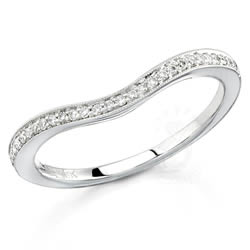To choose moissanite or not to choose moissanite – that is the question. But what is the answer? Well, it’s not as clear cut (excuse the semi-pun) as you would like. It requires a little research, which you should do before a major purchase anyway.
Here are some of the pros and cons, as listed on the Diamonds-are-Forever website:
The Pros and Cons of Moissanite – The Pro’s
- Cost – The cost of Moissanite is roughly an eighth of the price of natural diamonds but is generally more expensive that Cubic Zirconia at one tenth of the price of natural diamonds
- Appearance – Moissanite is so optically close to diamond that even some jewelers cannot tell the difference without the aid of various tests
- Clarity – Moissanite is not separated into different grades of Clarity like diamonds because each stone must meet set specifications before being released to distributors. The set specifications of Moissanite are comparable to diamonds which have been graded VS1-VS2 on the Diamond Clarity Chart
- Inclusions / Flaws – Manufactured to appear more like diamonds, Moissanite gemstones have inclusions which is a plus-point when compared to the flawless Cubic Zirconia – the growing process produces tiny, unnatural, white, ribbon-like inclusions
- Moissanite stones are equivalent to the H – J grades in the white Diamond Color scale. Moissanite is not as white-white like the Cubic Zirconia (which is equivalent to a perfect “D” and therefore less believable imitation, as white-white color diamonds are extremely rare.
- Hardness – Hardness denotes resistance to scratching as opposed to Toughness which relates to the ability to resist breakage from falls or impacts. Moissanite is much harder than most natural gems, and Cubic Zirconia, at about 9.5 on the Mohs scale, however it is nowhere near as hard as a diamond at about 10.0 on the Mohs scale
- Toughness – Moissanite is tougher than diamond because it has no natural fractures that can crack if the stone is subjected to an impact of some kind.
- Moissanite has a slightly higher index of refraction (brilliance) and much greater dispersion (fire) than diamond. It retains its fire if it gets dirty, oily, or smudged, whereas Cubic Zirconia looks very dull when dirty. The excess fire is seen as a ‘pro’ by some and a ‘con’ by others
Moissanite – The Con’s
- Investment – Jewelry containing synthetic gemstones like Moissanite are not a good investment – they do not hold their price.
- Color – Can have a slight yellowish / greenish tint which becomes more noticeable with increasing gem sizes.
- Fluorescence – An undesirable hazy effect that causes them to appear slightly green or yellow. The effect of fluorescence on Moissanite is much greater under natural light or in sunlight.
- Moissanite is highly birefringent (a birefringent crystal splits a light beam into two) which is a desirable quality in some optical applications, but is not desirable in gemstones. Moissanite jewels are therefore cut along the optic axis of the crystal to minimize birefringent effects
- Fire – Has more ‘fire’ or brilliance producing a more synthetic effect. The high dispersion of 0.11 is apparent in Moissanite (nearly 2.5 times greater than that of diamond) and readily distinguishes it from diamond with a dispersion of 0.04 which is virtually unnoticed. The excess fire is sometimes considered cheap and fake looking.
- Hardness – Diamonds are harder than Moissanite which is 9.5 on the Mohs scale compared to a diamond at about 10.0 on the Mohs scale
- Inclusions / Flaws – Manufactured to appear more like diamonds, Moissanite gemstones have inclusions. Natural flaws are absent in Moissanite replaced instead by tiny, unnatural, white, ribbon-like structures that are a result of the growing process.
- Rarity – Moissanite is not rare and can be made quickly and in vast quantities, whereas natural diamonds take millions of years to form.
- Symbolic Value – Diamonds have long symbolised love and purity – Moissanite has no such symbolic value yet.
Because our moissanite comes from Charles and Colvard, the creators and top manufacturers with the highest standards in moissanite, you can be assured your choice is a smart one. But again, research is key. A jewelry purchase is for life, and we understand that.

